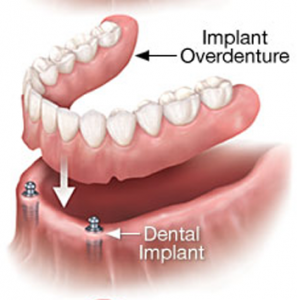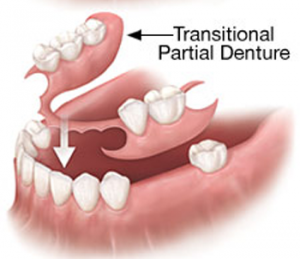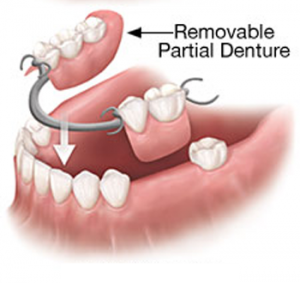A Flexible Partial Denture is unbreakable, very light weight & transparent. Patients find it very comfortable as it completely eliminates the metal clasps as in conventional Partial Dentures.Dentures are prosthetic devices constructed to replace missing teeth, and which are supported by surrounding soft and hard tissues of the oral cavity. Conventional dentures are removable, however there are many different denture designs, some which rely on bonding or clasping onto teeth or dental implants. There are two main categories of dentures, depending on whether they are used to replace missing teeth on the mandibular arch or the maxillary arch. There are many colloquial terms for dentures such as dental plate, false teeth, choppers falsies & gnashers.
Dentures can help patients in a number of ways:
- Mastication – chewing ability is improved by replacing edentulous areas with denture teeth.
- Aesthetics – the presence of teeth provide a natural facial appearance, and wearing a denture to replace missing teeth provides support for the lips and cheeks and corrects the collapsed appearance that occurs after losing teeth.
- Phonetics – by replacing missing teeth, especially the anteriors, patients are better able to speak by improving pronunciation of those words containing sibilants or fricatives.
- Self-Esteem – Patients feel better about themselves.
Types of Full Dentures

Immediate Dentures: These are usually a temporary means of helping you transition to successful denture wearing. Because of the muscular readjustment required, as well as the natural shrinkage of gums, the dentures which are placed immediately after tooth extraction won’t fit as well as permanent dentures made when the healing is complete. They do, however, provide you with new teeth right away, and give you time to adjust.
Conventional Full Dentures: After a period of time, we can fabricate permanent dentures that conform to your mouth with near-perfect accuracy. These are carefully crafted to look as much like your own natural teeth as possible, and are able to function properly in your mouth for a long time.
 Implant-Supported Overdentures: To increase the stability of a lower or upper denture, it’s possible for it to be securely anchored using two or more dental implants. The upper jaw requires more implants (generally three or more) than the lower jaw due to a lesser bone density. Many people find this option offers a great balance of comfort, functionality and value.
Implant-Supported Overdentures: To increase the stability of a lower or upper denture, it’s possible for it to be securely anchored using two or more dental implants. The upper jaw requires more implants (generally three or more) than the lower jaw due to a lesser bone density. Many people find this option offers a great balance of comfort, functionality and value.
Types of Partial Dentures

Transitional Partial Dentures: These relatively inexpensive removable plastic dentures serve as a temporary tooth replacement and space maintainer as you wait for your mouth to heal from tooth extraction, for example. Once the healing process is complete, dental implants can be placed.

Removable Partial Dentures (RPDs): Usually made of cast vitallium, these well-constructed, metal-based removable partial dentures are much lighter and less obtrusive than those made of plastic. They are a little more expensive than plastic dentures but will fit better. They are, however, much less expensive than implants or fixed bridgework.

